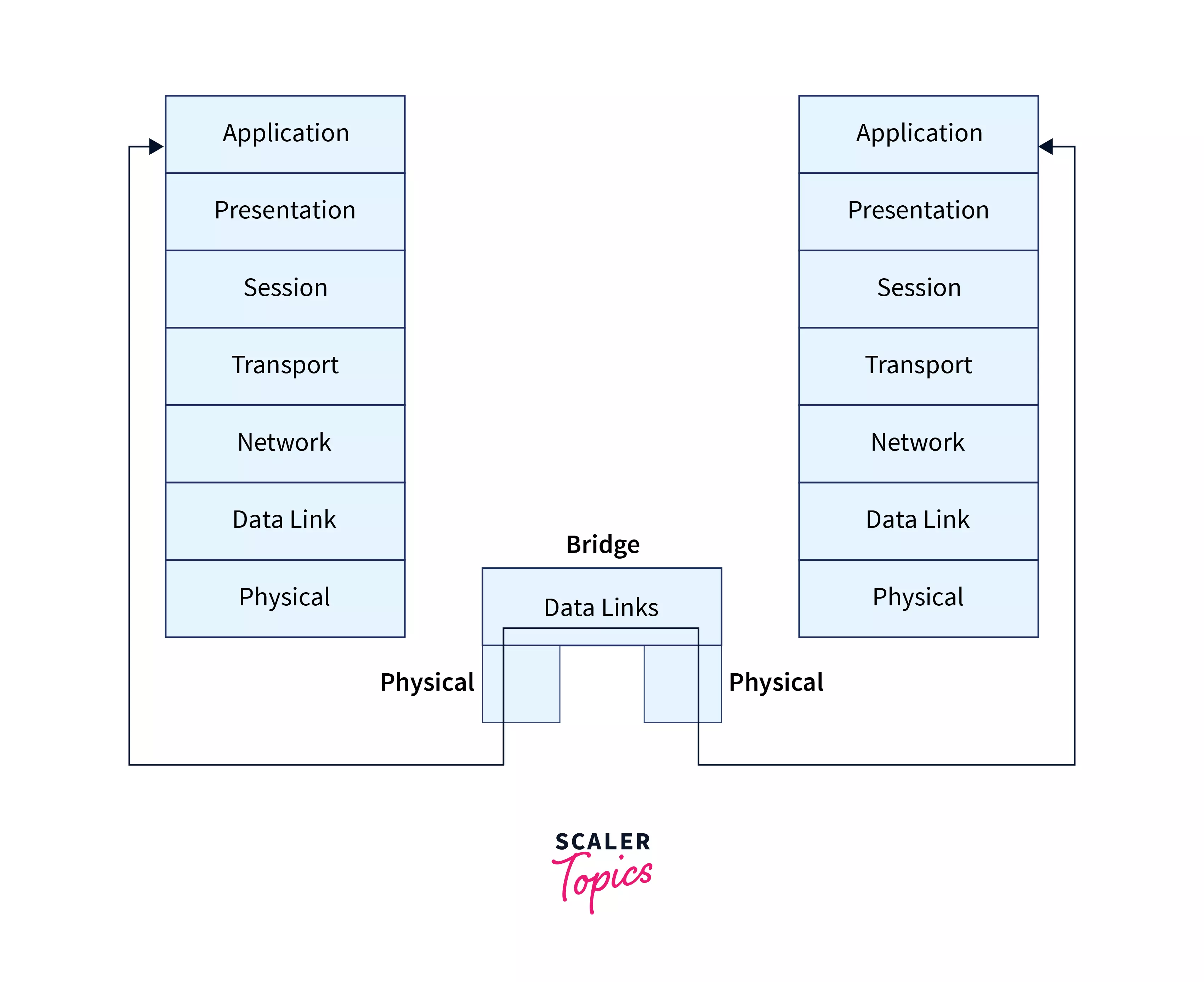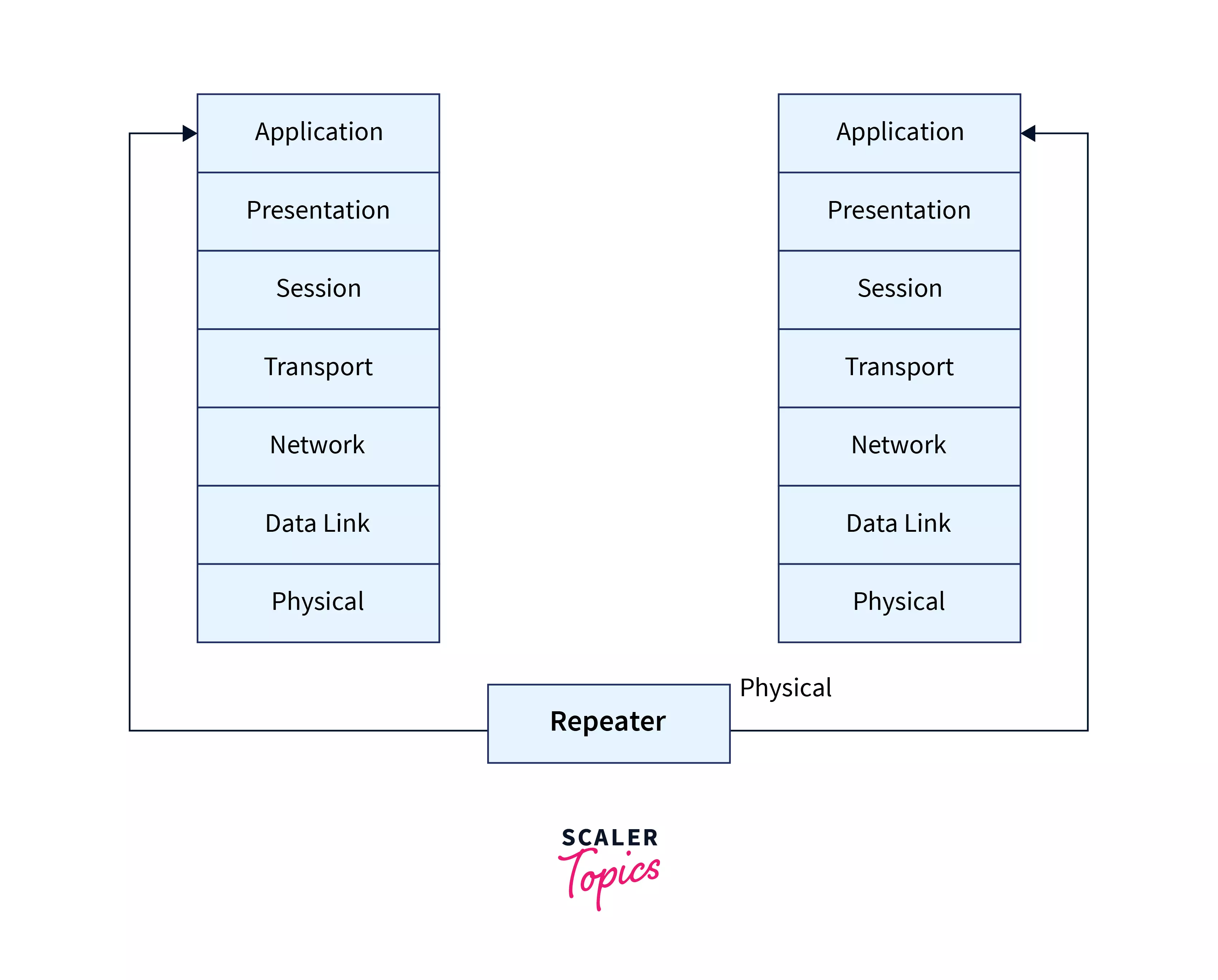A bridge is a computer networking device that connects multiple LANs (Local area networks) together to create a single, larger LAN. The process of aggregating networks is referred to as network bridging. Bridges operate at the data link layer according to the OSI model. A repeater is also a computer networking device operating at the OSI model’s physical layer that regenerates the weak signal and increases its range before retransmitting it. Repeaters are incorporated into the network to expand its coverage area.
What are Bridges?
A bridge is one of the computer networking devices that works at the second layer (Data link layer) of the Open Systems Interconnection (OSI) model. These devices are used to divide a huge network into smaller segments, each of which represents a different collision domain, so the number of collisions on the network is decreased. Each collision domain has its own distinct bandwidth, so its performance improves.

Bridges broadcast data to every node, just like repeaters and hubs do. However, bridges keep the media access control (MAC) address table up to date as soon as they discover new segments, ensuring that only the desired recipient receives subsequent transmissions.

What are Repeaters?
A repeater is one of the computer networking devices that operates at the physical layer of the OSI model. It regenerates the weak incoming signal from the sender before retransmitting it to the receiver. A repeater is also known as a Signal Booster.

Signals degrade and acquire distortion when they travel through a network cable (or any other transmission medium). This process is known as attenuation. A signal will eventually become unrecognizable by the receiver if a cable is long enough. The signal can travel longer distances when transmissions are extended using repeaters. Repeaters regenerate the received signals and then retransmit the regenerated signals to other segments.

Bridge Vs Repeater
The following table illustrates the bridge vs. repeater comparison.
| Sr. No. | Parameter | Bridge | Repeater |
|---|---|---|---|
| 1. | Operation | Bridge operates at the second layer (Data link layer) of the Open Systems Interconnection (OSI) model. | Repeater operates at the first layer (physical layer) of the Open Systems Interconnection (OSI) model. |
| 2. | Address | Bridge uses the destination address to determine where to forward a frame. | Repeaters cannot recognize the destination address. |
| 3. | Packet | Bridges understand the complete frames. | Repeaters do not understand the complete frames. |
| 4. | Domain | If a collision occurs in a network segment, it is not forwarded to another segment by a bridge. | Repeaters forward collisions from one segment to another, resulting in the same issue on all other segments in the network. |
| 5. | Filtering | A bridge achieves filtering of the packets in the network. | A repeater cannot perform packet filtering. |
| 6. | Networks | Bridge connects two networks in a well-organized manner. | Repeater expands the network’s signal limit. |
| 7. | Economical | Bridges are used to expand a LAN and are relatively more expensive than the repeaters. | Repeaters are also used to extend a LAN but are more cost-effective than bridges. |
Features of Bridges
- Bridges are transparent to higher-level protocols since they operate at the data link layer.
- Bridges reduce the number of collisions on the network by dividing a large network into smaller segments, each representing a different collision domain.
- The bridge increases the number of connected workstations and network segments.
- Bridges improve network reliability and make the network easier to maintain by dividing the LAN into smaller segments and reducing congestion.
- Bridges are slower than repeaters because they introduce delays due to frame buffers.
- Bridges are more expensive than repeaters.
- Bridges provide no filtering of the broadcast frames.
Features of Repeaters
- Repeaters are connected to one another at the physical layer.
- As the signals travel a longer distance, they become weaker. The purpose of the repeaters is to enhance the weak signals and make them stronger for data transmission.
- Repeaters can support dynamic networking.
- Repeaters can eliminate the distance between two devices.
- Repeaters provide filtering of the broadcast frames.
- Repeaters can frequently monitor the signals that are created between the two LANs.
- A repeater transmits the signals to the weaker locations in order to strengthen the system signals.
Conclusion
- Bridges and repeaters belong to the class of computer networking devices.
- In the OSI model, the repeater operates at the physical layer and the bridge at the data link layer.
- Repeaters are used to extend wire length or to regenerate attenuated signals. On the other hand, bridges are used for logical segmentation of the network (LAN).
- Frames in a bridge are forwarded based on the MAC address. Inversely, a repeater is unable to understand any frames, packets, or bits.
- Bridges have a filtering capability, which is one of the main differences between a bridge and a repeater.